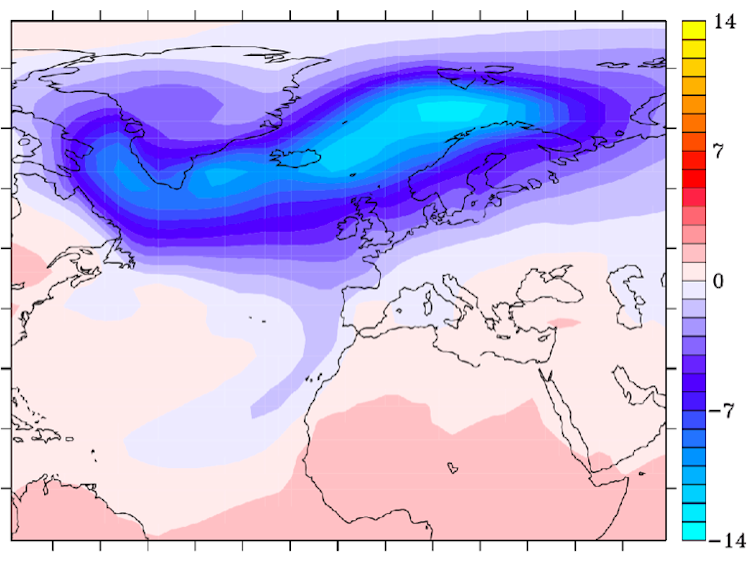As recently as 6,000 years ago the Sahara was green and fertile. We’ve found evidence of large rivers crossing the region, lined by flourishing settlements. Then suddenly things changed. Trees died and the land dried up. Soil blew away or turned into sand and those rivers were no more. In just a few centuries, the Sahara was transformed from a region similar to modern South Africa into the desert we know today.
This is an example of a “tipping point”. Just think of the climate like a chair. It takes a strong push to tip over a chair stood on four legs, but when it’s leaning on only two legs the required push becomes smaller. Indeed, if the inclination becomes large enough, it will tip over by itself.
Today, climate change inclination is increasing – and we know it could suddenly tip over, as our planet has previously witnessed several abrupt switches between different states. Along with what happened to the Sahara, there are also the flip-flops between ice ages and moderate conditions which happened every 1,000 years, before things settled down 10,000 years ago.
The idea that global warming might destabilise many climate systems and give rise to abrupt transitions was explored in the movie The Day After Tomorrow, in which melting ice shelves caused a sudden reversal in Atlantic currents – and a worldwide catastrophe.

The idea of climate tipping points was explored more rigorously by a team of scientists led by myself for a study recently published in the journal PNAS. We looked at all the simulations performed by 37 climate models that had been used to inform the Intergovernmental Panel of Climate Change (IPCC) – together with their historical and pre-industrial simulations. That gave us a gigantic amount of data: around 1015 bytes divided over several computer servers around the world.
We detected 37 cases of abrupt change, distributed over three different climate change scenarios. These include the Arctic becoming ice-free even in winter, the Amazon rainforest dying off and the total disappearance of snow and ice cover on the Tibetan Plateau.
There’s a 30% chance that at least one of these tipping points will be crossed over the next 200 years. This increases to 50% in the most aggressive warming scenario. However, the likelihood of crossing any individual tipping point is much lower, only a few percentage points. So the Himalayas will probably still retain at least some of their glaciers. You should still be able to stand on the North Pole in January. But, taken together, there’s a decent chance that something major will happen.
One of the most important findings is that 18 out of 37 abrupt changes are likely to occur when global temperature rises are 2°C or less, often presented as an upper level of “safe” global warming. Our results imply that there is no window of “safe” global warming and no threshold separating safe and dangerous climate change. Every 0.5°C temperature increase is similarly dangerous.
Tipping points we might reach
Many of the tipping points we found apply to sea ice and ocean circulation. Because seawater reflects less sunlight than ice – and absorbs more heat – disappearing sea ice means further local warming, which in turn means more melting sea ice. This process may quickly amplify the effect of global warming. Most climate models simulate an abrupt disappearance of all summer sea-ice in the Arctic at some point this century.
Sometimes models predict the reverse process will occur, with sea-ice forming in regions that were previously open water. For instance, water draining from the Greenland and Antarctic ice sheets, combined with increased precipitation and melting sea ice may lead to ocean surface waters becoming fresher and lighter than usual. In the far north Atlantic, this would prevent the mixing between colder surface water and heat from the deep ocean that usually takes place in the region. With heat remaining deep in the ocean, the resulting cooling would be more widespread – one model predicted that by 2060 the Baltic Sea could almost entirely freeze over every winter.

In two scenarios this process is associated with a collapse of the Atlantic circulation that brings warm water from the Southern Hemisphere to cold seas around Greenland where it sinks. A collapse of all sinking shuts this circulation down.
This is The Day After Tomorrow scenario. I recently wrote a separate paper analysing the possible effects of such a collapse in oceanic currents – it’s more plausible than you might think and it really would lead to global cooling. In fact, depending on continued emissions levels, the effects could even outweigh global warming for decades to a century, especially in the Northern Hemisphere.
Such sudden transitions are more rare on land, but some models predict that a 2.5°C warming could cause the Amazon rainforest to disappear within 200 years. Forests contain a lot of moisture, and evaporation keeps the local climate cool. If trees start dying the region will grow warmer and drier, which will kill more trees.
Most climate models still don’t even factor in how vegetation will respond to changes in climate – and improvements in this respect would probably lead to more predictions of land-based “tipping points”. Likewise, ice sheet collapses and carbon and methane release from thawing permafrost could also lead to abrupt transitions but aren’t yet included in climate models.
For these reasons my colleagues and I believe that the catalogue of abrupt shifts we found is actually at the lower end of what might occur in reality. Dangerous climate change isn’t restricted to 2°C global warming or more – to avoid unpleasant surprises we should limit it as much as possible.

